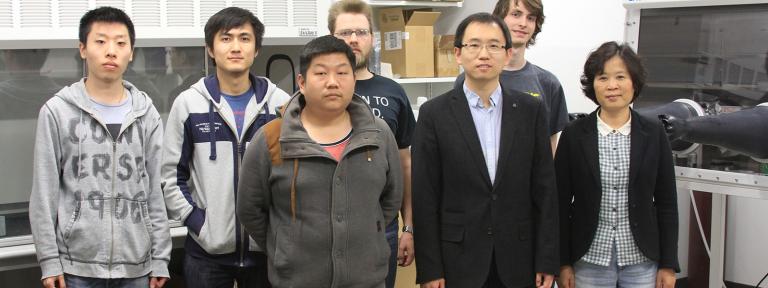
“Sodium is very common -- we even eat it every day. Sodium could be a viable replacement for lithium in some applications and it would be much safer and cheaper on both cathodes and anodes.”
The acceptance of electric vehicles is becoming increasingly common, and the Innovation Center at Kettering University is serving as the home to research of a critical element to mass proliferation of EVs -- the battery.
“Batteries and energy storage in Michigan is a hot industry,” said Dr. Xuan (Joe) Zhou, assistant professor of Electrical Engineering at Kettering. “The future of vehicles is electric and the core parts are the motor, battery and power electronics -- those are all electrical engineering components.”
Zhou and a team of researchers moved into the Innovation Center in late 2014 in order to expand their battery research capabilities. His team includes a visiting Ph.D student and visiting scholar from China, a Kettering graduate student and three undergraduate students. The lab was a necessity for the type of work the team is doing.
Dr. Jim McDonald, Kettering Electrical and Computer Engineering department head and Kettering director of sponsored research and graduate studies Tom Creech were all instrumental in helping Zhou get the space set up.
“We needed a space like this,” Zhou said. “Building this lab gives students opportunities to see what is going on in the battery research area. The lab and the group I’m working with are growing and doing well with the help of many people.”
The group hopes to eventually build a complete sodium ion battery, and work in the lab includes energy generation storage and utilization and work with both the cathode and anode. The group is synthesizing the materials, then assembling the battery for application and testing. They’d like to build a sodium ion battery that could serve as an alternative to lithium ion for some uses.
“Lithium is a limited raw material and resource, and it’s quite expensive,” Zhou said. “Sodium is very common -- we even eat it every day. Sodium could be a viable replacement for lithium in some applications and it would be much safer and cheaper on both cathodes and anodes.”
Zhou noted that sodium ion batteries could be a cost-effective way to store wind and solar energy, for example. He also pointed out that Faradion, a British company, has developed a prototype of a sodium ion-powered bicycle.
“People are still unsure whether sodium ion could replace lithium ion on a large scale, but this bike shows that it can work,” Zhou said.
The work in Zhou’s lab is unique because it is focusing on holistic research -- rather than just studying certain components, researchers are integrating all components in order to eventually make their own battery.
“Some universities are studying one or two of the components of batteries,” Zhou said. “I’d like to go further and put all of the components together to see how they work together and affect each other. We’re hoping to eventually do energy harvesting and storage as the big picture application of the lab.”
The work in Zhou’s lab has elements that spread across many academic disciplines. “This is an interdisciplinary area,” Zhou said. “If you look at faculty around the world doing work that involves batteries, you’ll see people from electrical engineering, chemical engineering, materials sciences, mechanical engineering -- the collaboration opportunities are very interesting.”
Long-term, Zhou is hoping his team and other collaborators can develop a sodium ion battery. The goal would be to create an alternative, efficient battery that could power everyday items -- like children’s toys, for example.
In the short-term, Zhou is simply hoping to provide new opportunities for students.
“We’re working very hard on hands-on research that is more than just talking about batteries -- this provides an opportunity to try and build one, or work with the materials,” Zhou said. “We’re trying to expose students to new things and give them more opportunities.”